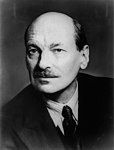1945 United Kingdom general election in England
| |||||||||||||||||||||||||||||||||||||||||||||
All 510 English seats in the House of Commons 256 seats needed for English majority | |||||||||||||||||||||||||||||||||||||||||||||
|---|---|---|---|---|---|---|---|---|---|---|---|---|---|---|---|---|---|---|---|---|---|---|---|---|---|---|---|---|---|---|---|---|---|---|---|---|---|---|---|---|---|---|---|---|---|
| |||||||||||||||||||||||||||||||||||||||||||||
The 1945 United Kingdom general election was held on Thursday 5 July 1945 to elect 640 members of the House of Commons, of which 510 constituencies were in England. It was the first general election held since the conclusion of the Second World War and nearly 10 years since the last general election in November 1935. It led to the first majority victory of the Labour Party in the House of Commons and England. It was also the first time that the Labour Party won the popular vote in any general election in England as well as the nation. Conversely, it was the first election since 1906 that the Conservative Party did not win the largest share of votes in the nation as well as England. For the rest of the 20th century, the Labour Party would win a majority of seats in England only in the 1966 and 1997 elections.
The 331 seat tally of the Labour Party remained the highest number of seats it ever won in England until the 2024 general election under Sir Keir Starmer. The voteshare of Labour in England has been exceeded only once since then- in 1951.[1][2][3]
Result Table
[edit]| Party | Seats won | Net change in seats | Total votes (in millions) | Voteshare | Change in voteshare |
|---|---|---|---|---|---|
| Labour | 331 | 9.97 | 48.5% | ||
| Conservative | 167 | 8.27 | 40.5% | ||
| Liberal | 5 | 1.91 | 9.4% |
References
[edit]- ^ Harmer, Emily (2021-10-06), "The Candidates: Making the House (of Commons) Their Home?", Women, media and elections, Policy Press, pp. 21–57, ISBN 978-1-5292-0494-0, retrieved 2024-10-23
- ^ McCulloch, Gary (October 1985). "Labour, the Left, and the British General Election of 1945". The Journal of British Studies. 24 (4): 465–489. doi:10.1086/385847. ISSN 0021-9371.
- ^ Burgess, Simon (June 1991). "1945 observed ‐ a history of the histories". Contemporary Record. 5 (1): 155–170. doi:10.1080/13619469108581164. ISSN 0950-9224.
Further reading
[edit]- Fry, G.K., 1991. A Reconsideration of the British General Election of 1935 and the Electoral Revolution of 1945. History, 76(246), pp.43-55.
- Lindsay, T.F. and Harrington, M., 1979. The General Election of 1945. In The Conservative Party 1918–1979 (pp. 141-146). London: Palgrave Macmillan UK.
- Pelling, H. and Pelling, H., 1984. The 1945 General Election. The Labour Governments, 1945–51, pp.17-33.
- Harrison, L.H. and Crossland, F.E., 1950. The British Labour Party in the General Elections, 1906-1945. The Journal of Politics, 12(2), pp.383-404.



